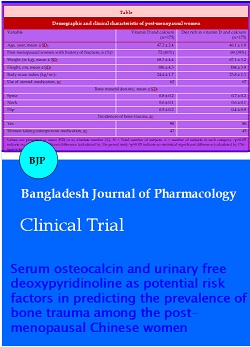Serum osteocalcin and urinary free deoxypyridinoline as potential risk factors in predicting the prevalence of bone trauma among the post-menopausal Chinese women
Abstract
This study was designed to understand whether the post-menopausal Chinese women (n=175) receiving tablet containing vitamin D (500 IU) and calcium (500 mg) had lower incidence of bone fracture compared to the post-menopausal Chinese women ((n=175) receiving a diet rich in calcium, vitamin D, and protein (milk, cheese, and yogurt, soybeans, spinach, fish including fatty fish, cheese, egg). This study assessed whether the levels of serum osteocalcin and urinary free deoxypyridinoline could be used as predictors of early bone trauma during post-menopausal period. After randomization, subjects were followed-up for up to 3 years to capture required data. The results suggested that therapeutic intervention (vitamin D and calcium) does not predict bone fracture among the post-menopausal Chinese women. However, correlation analysis revealed that the decreased level of serum osteocalcin and urinary free deoxypyridinoline were associated with higher incidence of fracture. The results suggest that the low level of serum osteocalcin and urinary free deoxypyridinoline cause increase susceptibility of fracture among the post-menopausal Chinese women.
References
Alswat KA. Gender disparities in osteoporosis. J Clin Med Res. 2017; 9: 382-87
Blank RD, Bockman RD. A review of clinical trials of therapies for osteoporosis using fractures as an end point. J Clin Densitometry. 1999; 2: 435-52.
Cawthon PM. Gender differences in osteoporosis and fractures. Clin Orthop Relat Res. 2011; 469: 1900-05.
Jackson RD, LaCroix AZ, Gass M, Wallace RB, Robbins J, Lewis CE, Bassford T, Beresford SA, Black HR, Blanchette P, Bonds DE. Calcium plus vitamin D supplementation and the risk of fractures. N Engl J Med. 2006; 354: 669-83.
Jensen JEB, Kollerup G, Sorensen HA, Sorensen HS. Intra-individual variability in bone markers in the urine. Scand J Clin Lab Invest. 1997a; 57: 29-34.
Jensen JEB, Nielsen SP, Kollerup G, Sorensen HA, Sorensen OH. A single measurement of biochemical markers of bone tumover has limited utility in the individual person. Scand J Clin Lab Invest. 1997b; 57: 351-60.
Kaufman JM, Johnell O, Abadie E, Adami S, Audran M, Avouac B, Sedrine WB, Calvo G, Devogelaer JP, Fuchs V, Kreutz G, Nilsson P, Pols H, Ringe J, Van Haelst L, Reginster JY. Background for studies on the treatment of male osteoporosis: state of the art. Ann Rheum Dis. 2000; 59: 765-72.
Khoshhal. Osteoporosis. J Taibah Univ Med Sci. 2011; 6: 61-76.
Nawawi HM, Yazid TN, Ismail NM, Mohamad AR, Nirwana SI, Khalid BA. Serum bone specific alkaline phosphatase and urinary deoxypyridinoline in postmenopausal osteoporosis. Malays J Pathol. 2001; 23: 79-88.
RECORD Trial Group. Oral vitamin D3 and calcium for secondary prevention of low-trauma fractures in elderly people (Randomised Evaluation of Calcium Or vitamin D, RECORD): A randomised placebo-controlled trial. Lancet 2005; 365: 1621-28.
Tsai K, Twu S, Chieng P, Yang R, Lee T. Prevalence of vertebral fractures in Chinese men and women in urban Taiwanese communities. Calcif Tissue Int. 1996; 59: 249-53.
Uebelhart D, Schlemmer A, Johansen JS, Gineyts E, Christiansen C, Delmas PD. Effect of a menopause and hormone replacement therapy on the urinary excretion of pyridinium cross-links. J Clin Endocrinol Metab. 1991; 72: 367-73.
Wang Y, Tao Y, Hyman ME, Li J, Chen Y. Osteoporosis in China. Osteoporos Int. 2009; 20: 1651-62.
Zhang ZQ, Ho SC, Chen ZQ, Zhang CX, Chen YM. Reference values of bone mineral density and prevalence of osteoporosis in Chinese adults. Osteoporos Int. 2014; 25: 497-507.

Apply citation style format of Bangladesh Journal of Pharmacology
Copyright (c) 2018 Weimin Jiang, Anqing Jiang, Yijie Liu, Xuefeng Li, Jie Chen, Heng Wa

This work is licensed under a Creative Commons Attribution-NonCommercial 4.0 International License.
